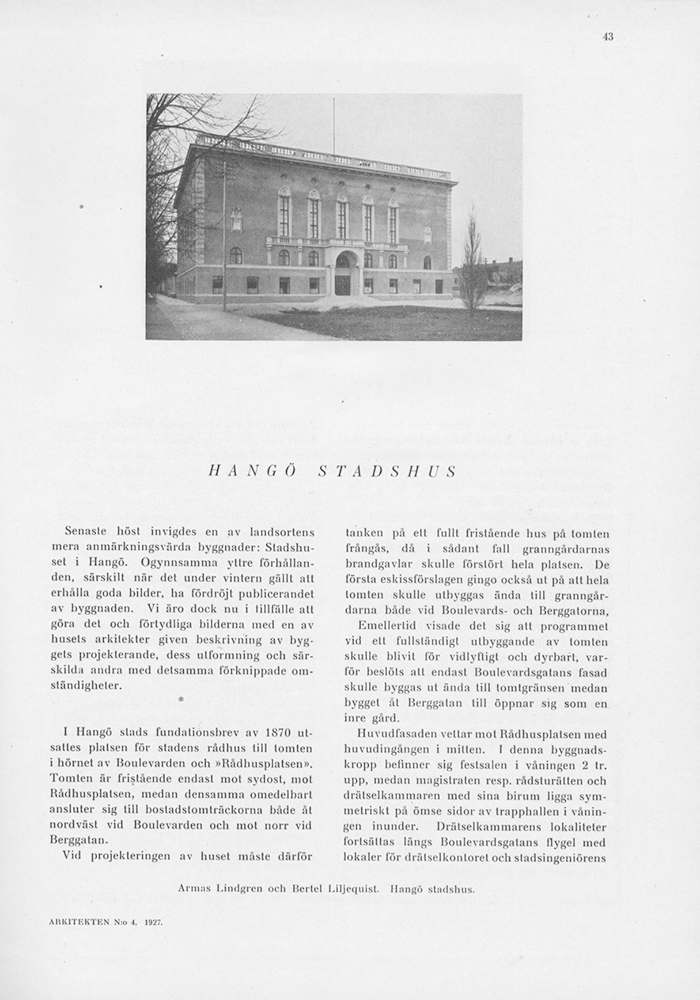
Hanko's town hall was completed in September 1926. The designers of the building were Armas Lindgren and Bertel Liljequist. The activity in the town hall was lively. There were concerts, plays, dance performances and lectures. Of course, the entire city administration was also in the building. In 1941, the Continuation War began, and Russian troops blew up the town hall when they retreated from the city in December. The current town hall was completed in 1951.
Laura Lotta Andersson | Hanko Museum
16. toukokuuta 1925 oli Hangossa suuri päivä kun Hangon ensimmäisen kaupungintalon peruskivi muurattiin Bulevardin, Raatihuoneenpuiston ja Vuorikadun kulmassa sijaitsevalle tontille. Paikalle oli saapunut sankka joukko todistamaan tätä juhlallista hetkeä. Olihan kaupunki jo ollut 51 vuotta olemassa, ja lopulta saatiin oma kaupungintalo. Ja komea siitä olisi tulossa. Piirustukset olivat esillä Hangon kirjakaupan näyteikkunassa. Suunnittelijoina olivat Armas Lindgren ja Bertel Liljequist. Armas Lindgren oli 1900-luvun vaihteessa työskennellyt Herman Geselliuksen ja Eliel Saarisen kanssa, mutta vuodesta 1905 alkaen Lindgrenilla oli oma toimisto, jonne Liljequist tuli töihin 1914.
Kaupungintaloa pidettiin erittäin komeana 8 600 hengen kaupungissa. Pääjulkisivu oli Raatihuoneenpuistoa päin. Kivijalka ja pylväät olivat Hangon Granitin valmistama, muuten nelikerroksinen rakennus oli rapattu. Kaupungintalo oli syyskuussa 1926 valmis, mutta marraskuussa oli kahden päivän juhlallisuudet kun rakennus vihittiin käyttöön. Täällä oli tilat kaupungin eri virastoille ja kaupunginvaltuuston kokoustilat. Suuri juhlasali ja lämpiö olivat Raatihuoneentorille päin. Talossa toimi myös kirjasto, Säästöpankki, Karl Boströmin huolintaliike, ravintola Raatihuoneenkellari sekä suojeluskunta ja Lotta Svärd.
Toiminta kaupungintalossa oli vilkasta kun seuraa, mitä kaikkia tapahtumia juhlasalissa järjestettiin. Oli konsertteja, näytelmiä, tanssiesityksiä ja luentoja. Tietysti oli myös koko kaupungin hallinto rakennuksessa. Hangonlehdessä luki aina minä päivinä ja miten monta tuntia kukin toimisto oli auki.
1930-luvulla tilanne Euroopassa synkkeni kun totalitaariset valtionmiehet nousivat valtaan, mutta talvisodan puhkeaminen oli kuitenkin järkytys. Sodan päättyminen 13.3.1940 johti Hangon luovuttamiseen neuvostoliittolaiseksi meritukikohdaksi 30 vuodeksi. Kaupunki piti tyhjentää kymmenessä päivässä ja kaupungintalolta johdettiin Hangon evakuointia.
Kesällä 1941 alkoi jatkosota ja tämä johti siihen, että venäläiset lähtivät kaupungista joulukuussa 1941. Sitä ennen he kuitenkin räjäyttivät kaupungintalon ja vesitornin. Kirkkokin oli miinoitettu, mutta se ei räjähtänyt. Kaupungintalosta jäi jäljelle vain Bulevardin puoleinen seinä. Talo ehti olla vain 15 vuotta pystyssä. Kun se rakennettiin, sitä pidettiin huomattavana rakennuksena maaseudulla.

Uusi vesitorni saatiin nopeasti rakennettua, mutta kaupungintaloa saatiin odottaa muutama vuosi. Rakennustyöt alkoivat 1950 ja valmistuivat 1951. Hangö-lehti seurasi tiiviisti rakennushanketta, joka eteni hitaasti materiaalipulan takia, varsinkin lasista oli puutetta, sen lisäksi oli myös lakkoja. Arkkitehtina toimi jo edellisen kaupungintalon suunnittelussa mukana ollut Bertel Liljequist. Apunaan hänellä oli Sam Salvesen. Kaupungintalo oli silloisen kaupunginjohtajan Elis Vennströmin mukaan symboli hankolaisten tahdosta uudelleen rakentaa kaupunki paremmaksi ja kauniimmaksi kuin mitä se oli 1940, kun Hangosta luovuttiin. Mukana juhlimassa uutta kaupungintaloa olivat myös ystävyyskaupunkien edustajat Ruotsin Halmstadista ja Tanskan Gentoftesta.
Tyyliltään uusi kaupungintalo oli ihan erilainen edelliseen verrattuna. Talo koostuu kahdesta osiosta. Bulevardille ja Kirkkopuistoon päin on nelikerroksinen osa, jossa on kaupunginvaltuuston sali ja toimistotiloja. Kirkkopuistoon ja Vuorikadulle on kaksikerroksinen osa, jossa oli alun perin kirjasto, jossa nykyään on kaupungintalon galleria ja toimistoja sekä toisessa siivessä juhlasali lämpiöineen.

Photos: Hanko museum











